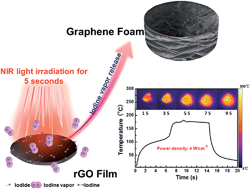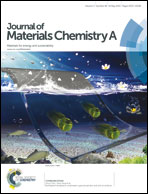Rapid formation of superelastic 3D reduced graphene oxide networks with simultaneous removal of HI utilizing NIR irradiation†
Abstract
Graphene foam with three-dimensional (3D) networks was formed following removal of the undesirable toxic iodide induced in a HI reduced GO film through NIR light irradiation via a near infrared (NIR) light irradiation method under ambient laboratory conditions. Compact reduced graphene oxide films were used as the precursors which were fabricated through vacuum filtration and HI reduction. A series of graphene foams which have alterable pore sizes ranging from a few to hundred micrometers rapidly formed under NIR light irradiation at different power densities. The graphene foam has an ultimate tensile strength of about 15.3 MPa and could be compressed at a very large strain (ε = 60%) for 200 cycles without significant plastic deformation or degradation in compressive strength. This 3D graphene network is hydrophobic and showed high absorbing abilities for organic liquids. The adsorbed oil weight is up to about 27 times the weight of graphene foam after being immersed in an oil–water mixture for two minutes, and 87.2% of adsorbed oil could be squeezed out and recycled. This process is highly repeatable, which makes our product a potential candidate for removal and recycling of oil for environmental protection.


 Please wait while we load your content...
Please wait while we load your content...